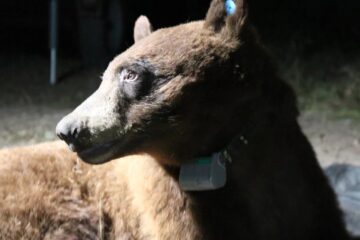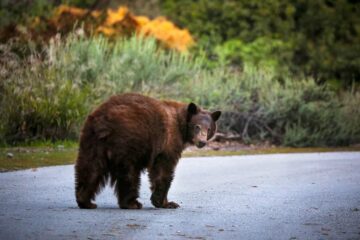Grizzlies May Lose Protection
Bears in the Yellowstone area could be cut from the endangered species list by year’s end, a move that some local ranchers have long sought.
Source of this article – Los Angeles Times, January 16, 2006.
By Julie Cart, Times Staff Writer

WILDLIFE: A grizzly rambles in a meadow in Yellowstone National Park, Mont. The bears have been protected for 30 years. (Jim Peaco / AP)
CODY, Wyo. — Federal officials have begun the process of removing grizzly bears around Yellowstone National Park from the endangered species list, ending 30 years of protection and shifting responsibility for their management to state officials who may allow hunting.
Seen as a major conservation success story, the Yellowstone population of grizzlies has increased about fourfold, from 150 to nearly 600 since going on the endangered list in 1975, and it is continuing to grow at an annual rate of 4% to 6%, according to the U.S. Department of Interior.
The federal delisting plan unveiled in Cody last week calls for maintaining the existing level of protection for bears within a 9,200-square-mile area in and around Yellowstone and Grand Teton national parks.
But special protections will be dropped outside that loose ring of federal land. Beyond it, where many grizzlies wander and 10% to 30% of them live, bear habitat will be open to road building, logging, recreation and development. Under the delisting plans, state officials in Wyoming, Montana and Idaho will take over management of the bears and may allow hunting outside the protected areas.
The new management plan, which is undergoing final revisions, could go into effect by the end of the year.
Although conservationists agree that the bears have rebounded, many say that the decision to strip protections comes at an inauspicious time for grizzlies. Two of their major food sources — cutthroat trout and seeds from white bark pine trees — are in a steep decline. And steady population growth is causing new homes and roads to be built deeper into the bears’ habitat.
“I think delisting is unwise,” said Idaho-based grizzly researcher Troy Merrill with the LTB Institute of Landscape Ecology. “Food sources are drying up at a faster rate than anticipated. The picture on habitat is much grimmer. Any bears that get too far away from Yellowstone will be eliminated. There will be no opportunity for genetic connectivity” with other grizzly populations, “or to spread into central Idaho, the best quality habitat south of Alaska. The grizzlies will basically be locked into an open-air zoo.”
Opponents of delisting also say they fear placing the fate of the Yellowstone grizzlies in the hands of states where there is pronounced hostility toward the bears. In Wyoming, for example, a few county commissions have passed resolutions that assert the right of local officials to shoot grizzlies on sight. In Montana, hunting of grizzlies was allowed near Glacier National Park until 1991.
At least one conservation group, the National Wildlife Federation, heralds delisting as a success story. Sterling Miller, a biologist with the group, said that since the required population levels have been met, there’s no reason not to delist.
“Rather than moving the goal posts in the last minute of the game, it’s appropriate to proceed with the delisting, absent compelling reason not to,” Miller said, adding that he believed states were well equipped to safeguard wildlife.
The Yellowstone grizzly population is the largest of five remnant groups in the lower 48 states. The others are in northern Montana and parts of Idaho and Washington, and will remain on the endangered list. The largest grizzly population lives in Alaska and is not endangered.
Tens of thousands of grizzlies once roamed across one-third of the continental United States, but a 19th century campaign of slaughter and contemporary patterns of growth and development have reduced both the bear population and habitat crucial for the animals’ existence.
Today, less than 1% of the former population of grizzlies remain, occupying less than 2% of their original land base in the lower 48.
Despite the protection afforded by the Endangered Species Act, bears die every year from a variety of causes, but the vast majority of deaths come from interaction with humans. In 2004, 19 grizzly deaths were recorded in the region, the highest bear mortality in 15 years. Most worrying to wildlife biologists was the fact that females made up 60% of the dead.
Federal officials said bears would continue to be closely monitored, pointing out that the post-delisting guidelines require a scientific review should the bear population drop below 500, or if there is a significant loss of habitat. If threats to the grizzly are deemed severe and immediate, the bears can be re-listed at any time, officials say, although that has never happened.
Since the Endangered Species Act became law in 1973, only 40 plants and animals have been removed from the list — nine because of extinction.
Grizzly bears have long been among the most popular tourist attractions in Yellowstone Park. But in surrounding communities, where the bears are often regarded as a menace, people have applauded the delisting decision.
Tom Bales, a rancher on the south fork of the Shoshone River outside of Cody, recalled an early morning in 1999 when his daughter came screaming into the house. Grizzlies had killed three of the girl’s 4H club sheep.
“That was an eye-opener,” said Bales, a supporter of delisting, at a public hearing last Tuesday where federal wildlife officials formally unveiled the delisting plan.

DEBATE: The only public hearing on the possible grizzly delisting was held in Cody, Wyo. Under the federal plan, bear habitat will be open to road building, logging, recreation and development. (Catherine Smith / For The Times)
The hearing, presented by the U.S. Fish and Wildlife Service at the vintage brick-and-stone Cody Auditorium, about 50 miles east of Yellowstone National Park, kicked off a public comment period that will last until Feb. 15.
Besides Bales, other ranchers complained that their herds of sheep and cattle had been harassed or decimated by the bears. Stockmen in Wyoming and other states are compensated when they lose animals to bear attacks.
However, more than a dozen speakers sharply rebuked the Fish and Wildlife Service for scheduling only one public meeting on an issue of national interest. The critics said it gave too much weight to local anti-grizzly sentiments and muted the concerns of the broader American public for the animals’ survival.
“I’m very disturbed that there is just one public hearing on something of national interest,” said Kathryn Hohmann, a resident of Bozeman, Mont., and a member of the Sierra Club.
“What if we decided to make some changes to the Statue of Liberty, maybe put a waterslide down from the torch? What if we had only one national hearing on that? What if we had it on Staten Island? How would everyone like that? Why didn’t we have a hearing in New York? Why didn’t we have a hearing in Denver? Why didn’t we have a hearing in California, where the state flag flies with a grizzly on it, and there are no grizzlies left there?”
Chris Servheen, the grizzly bear recovery coordinator for the Fish and Wildlife Service, said Tuesday that he had a budget of $1,500 for public meetings and the Cody hearing took all of it.
But on Friday, Montana Gov. Brian Schweitzer’s office announced that at the state’s request, the Interior Department will add another public hearing, possibly in Bozeman next month.
Servheen said his agency has received more than 60,000 comments on the grizzly delisting plan. All comments, no matter where they come from, will be equally weighed, he said.
“You know how they say all politics is local? All [wildlife] recovery is local,” Servheen said. “You have to involve local people in the decision. It can’t be handed down from afar on gold tablets. They have to be owners of the process.” Without state and local “buy-in,” he said, the future of grizzlies cannot be assured.
The debate over the fate of grizzly bears is fueled, in no small part, by the distaste many rural Westerners harbor for federal dictates, particularly as they affect land they consider to be their backyard.
Jon Robinette, who manages the Diamond G ranch near Dubois, Wyo., said in an interview that although he has been able to coexist with grizzly bears living near his cattle, few of his neighbors are as tolerant. And most of them don’t want “outsiders” making decisions that affect their lives and livelihoods.
“I guarantee if someone from California stood up and said, ‘I like bears and I want to keep them,’ people would come right up to you and say, ‘What right do you have getting into our business?’ Most Wyoming people don’t accept the fact that grizzlies are the national business.”
There is a long history of treating wildlife management as a national issue, and Americans have been arguing about it for almost as long, said Louis Warren, a history professor at UC Davis who has written many books on Western issues.
“It’s a very old conservation tradition for the nation to take an interest in wildlife,” Warren said. “These are public goods; they don’t belong to a county or a town.”
Tim French, a Park County supervisor in Cody, voted along with his colleagues a few years ago in support of a resolution that declared the grizzly was unwelcome in the county, asserting that county officials would “remove” problem animals. French said the resolution was meant to raise their local voice all the way to officials in Washington, D.C.
“It worked,” he said during a break in the Cody hearing. “We’re here talking about delisting. It had an impact. I think they heard us.”

